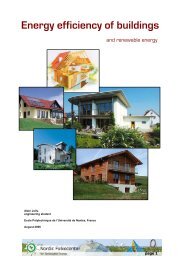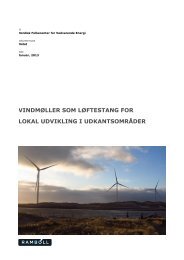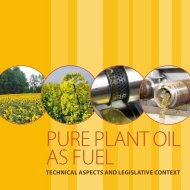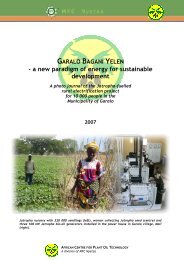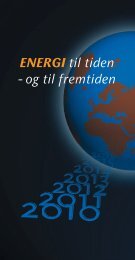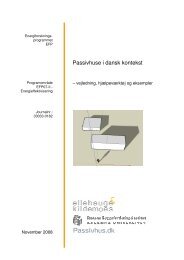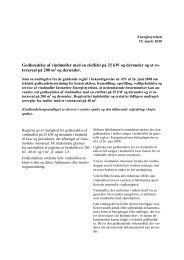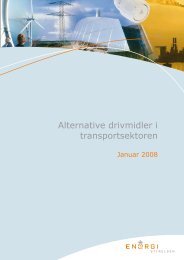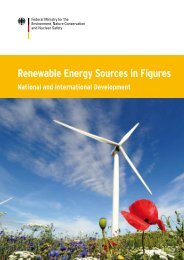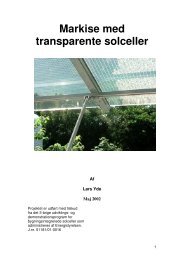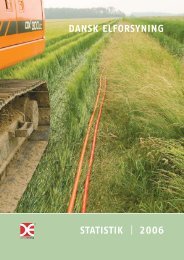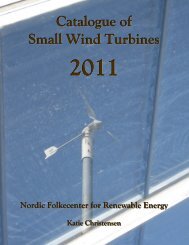What We Do - Nordic Folkecenter for Renewable Energy
What We Do - Nordic Folkecenter for Renewable Energy
What We Do - Nordic Folkecenter for Renewable Energy
You also want an ePaper? Increase the reach of your titles
YUMPU automatically turns print PDFs into web optimized ePapers that Google loves.
<strong>Nordic</strong> FolkeceNter For reNewable eNergy<br />
kammersgaardsvej 16, Sdr. ydby, dk-7760 Hurup thy<br />
www.folkecenter.net | info@folkecenter.dk<br />
tel +45 9795 6600 | Fax +45 9795 6565<br />
wHat we do<br />
welcome to the world of renewable energy and energy savings!<br />
experience modern energy technology and how can we play a worldwide role<br />
in transfer of technology and ecological way of thinking and acting.<br />
learn about solar and wind power, our work in africa and climate solutions right here in thy.
FoSSil-Free tHy<br />
FoSSil-Free tHy<br />
electricity from renewables: 100%<br />
Space heating from renewables: 85%<br />
In 2012 the <strong>Folkecenter</strong> opened a new project: Fossil-Free Thy. <strong>We</strong> initiate and coordinate a range<br />
of regional activities with in renewable energies and technologies which can be used in order<br />
to create new network connections, which improve the area’s external position in Denmark and<br />
the outside world as a showcase <strong>for</strong> climate solutions. This creates a solid foundation <strong>for</strong> future<br />
companies and jobs.<br />
Thy, our peninsula is almost completely self-sufficient with renewable energy. 100% of electricity<br />
and about 85% of heat supply is coming from renewable energy. But the area is aiming <strong>for</strong> 100%<br />
during a few years. For these achievemets Thisted received the prestigious European Solar Prize<br />
in 2007.<br />
in the thy peninsular with its 46 000 inhabitants, 225 windmills and other renewables<br />
cover 100% of the annual need <strong>for</strong> electricity. local energy production has become an<br />
important source of income. on days with strong wind, wind turbines may even produce<br />
four times more than the actual consumption and power quality still lives up to the highest<br />
standards. the local utility, thy-Mors energi has demonstrated real-time management of<br />
such big quantities of wind energy to visitors from all parts of the world. in the towns and<br />
villages in thy, people get their space heating from hot water pipelines in the streets. it is<br />
environmentally and economically the best solution to use the excess wind power <strong>for</strong> the<br />
actual supply and storage in the big hot water reservoirs of the local district heating suppliers<br />
instead of exporting the surplus power to neighboring countries sometimes at low-spot<br />
market prices. a new municipal energy foundation plans to own further windmills. in 2012,<br />
80 Mw of new capacity were in the planning process. income of the foundation may be up<br />
to €7 million per year earmarked <strong>for</strong> local energy initiatives which secures acceptance of<br />
the wind power and illustrates the benefits of change from investor policy to local supply.<br />
data thisted Municipality (2008):<br />
● 225 windmills<br />
● 124 600 kW installed wind power capacity<br />
● 35 800 k<strong>We</strong>l installed CHP capacity<br />
● Power from wind energy 265 GWh<br />
● Power consumption of 340 GWh<br />
● 80% from wind<br />
● 20% from biogas and CHP waste<br />
● A small amount of PV<br />
<strong>Nordic</strong> FolkeceNter <strong>for</strong> reNewable eNergy | www.folkecenter.net
POWER BALANCING<br />
No single renewable energy source can stand alone.<br />
renewable energy sources are clean and necessary alternatives to our power supply. Unlike<br />
conventional polluting methods of power production, their supply fluctuates and does not<br />
always match their consumption demands.<br />
a lack of balance between supply and demand of power means that there may periodically be<br />
an increasing problem of excess power from the combined supply from decentralized energy<br />
sources such as wind turbines, solar power and combined heat and power plants. Persistent<br />
global attachment to the dominant fossil fuel-based energy system has significantly limited<br />
the development of combined solar and wind energies fluctuating into coherent, autonomous<br />
systems. one consequence of this is that renewable energies when generated in excess remain<br />
unutilized or even wasted. wind turbines in regions with high shares of wind energy may be<br />
periodically shut down when they produce too much power. Similarly, when combined heat<br />
and power production coincide with excess wind energy, an excess power capacity may occur.<br />
the primary task there<strong>for</strong>e, is to integrate the various <strong>for</strong>ms of renewable energy, sometimes<br />
in combination with natural gas, in order to achieve the maximum utilization of renewable<br />
energy sources and supplies. to do so is daily practice in thy.<br />
THE SuPPLy DOCTRINE<br />
1. Further development can make wind & solar power the primary source <strong>for</strong> electricity<br />
and heating<br />
2. With local surplus of fluctuating electricity it will be used in local CHP plants<br />
and replace biomass and natural gas<br />
3. Biomass and natural gas are back-up storage when wind and solar energy is not sufficient<br />
4. Biomass and natural gas are limited resources and should not be used when sufficient<br />
solar and wind are available<br />
<strong>Nordic</strong> FolkeceNter <strong>for</strong> reNewable eNergy | www.folkecenter.net
district Heating & CHP in Thy<br />
Network of district Heating<br />
and CHP* plants in Thy<br />
10<br />
7<br />
9<br />
11<br />
*CHP = Combined Heat & Power<br />
Fc<br />
<strong>Nordic</strong> FolkeceNter <strong>for</strong> reNewable eNergy | www.folkecenter.net<br />
6<br />
8<br />
1<br />
5<br />
3<br />
4<br />
2
district Heating & CHP in Thy<br />
HaNStHolM<br />
Hanstholm 1 - heating plant (biomass)<br />
Hanstholm 2 - CHP with 10 MW boiler<br />
Supplies heat to Ræhr (4.5 km distance)<br />
4<br />
1<br />
VESLøS<br />
Heating plant (wood chips)<br />
SNedSted<br />
CHP plant (natural gas),<br />
6 MW electric boiler<br />
district<br />
Heating<br />
in thy<br />
8<br />
9<br />
FRøSTRuP<br />
Heating plant<br />
(waste wood)<br />
<strong>Nordic</strong> FolkeceNter <strong>for</strong> reNewable eNergy | www.folkecenter.net<br />
2<br />
5<br />
tHiSted<br />
CHP plant (waste); Geothermal<br />
heating; CSH (concentrated<br />
solar heating); Straw<br />
Supplies Hillerslev<br />
bedSted<br />
Heating plant<br />
(wood pellets)<br />
10<br />
VESTERVIG<br />
Heating plant<br />
(wood chips)<br />
Supplies Agger<br />
3<br />
ØSterild<br />
Heating plant (wood chips)<br />
6<br />
klitMØller<br />
CHP plant (natural gas)<br />
7<br />
VORuPøR<br />
CHP plant (natural gas),<br />
1 MW electric boiler<br />
11<br />
HuRuP<br />
1: Heating plant (wood chips)<br />
2: Heating plant (wood chips)
iNtegrated eNergy SySteM<br />
at the FolkeceNter<br />
FolkeceNter aUtoNoMoUS eNergy SySteM<br />
at the <strong>Nordic</strong> <strong>Folkecenter</strong> <strong>for</strong> renewable energy located in the thisted municipality, a prototype<br />
autonomous renewable energy system is installed. the energy system supplies heat<br />
and electricity to 2000 m 2 of offices, meeting rooms, laboratories, workshops, and residential<br />
facilities. Sources of energy supply are wind turbines of 75 kwel and 37 k<strong>We</strong>l, 42 kwth electric<br />
boiler, 35 kWth wood pellet stoker with automatic start-up and stop, 8 kwel/20 kwth plant oil<br />
CHP unit with automatic start-up and stop, 12 k<strong>We</strong>l PV and 50 m 2 solar thermal panels. wind<br />
and solar energy are the primary sources <strong>for</strong> heat and electricity. biomass (wood pellets and<br />
plant oil, PPO) is used <strong>for</strong> backup.<br />
the system is connected to the public grid. the overall principle is not-to-sell/not-to-purchase<br />
from the grid. The CHP unit, however, can operate in island mode in case of a power blackout.<br />
At summer nights with no wind and sufficiently stored solar-generated heat, the CHP unit<br />
will not start up; the grid will supply the need <strong>for</strong> power only, as there is no electric storage<br />
capacity in the system and the CHP generated heat would be wasted. In practice, excess wind<br />
power covers 60% of the annual demand <strong>for</strong> heat, with the balance coming from solar and<br />
biomass. the technology and strategy of the autonomous system was pioneered, developed<br />
and implemented by the <strong>Folkecenter</strong> in 2007 and in daily operation since. For a 100% supply<br />
of power and heat/cooling from renewable energies, the same principles and strategy should<br />
be applied at the regional and national level as well. initial steps have been taken at some of<br />
the local CHP stations. The system delivers a realistic solution to questions often made about<br />
alternative energy sources.<br />
The combined high CHP and wind power production causes a potentially major problem in the<br />
power sector. However, supply and demand can as demonstrated in the <strong>Folkecenter</strong> autonomous<br />
energy System be balanced by feeding on windy days the excess wind power into the<br />
electric boiler. the electric boiler makes it possible to avoid the combustion of wood pellets<br />
in the stoker and use of liquid biomass in the CHP unit at periods with excess wind and solar<br />
energy.With increased renewable energy shares in the future, more and more often fluctuating<br />
solar and wind energy will be sufficient to satisfy both the need <strong>for</strong> power and heat, and<br />
can be given priority, while solid and liquid biomass is reserved <strong>for</strong> periods without sufficient<br />
wind and solar.<br />
<strong>Nordic</strong> FolkeceNter <strong>for</strong> reNewable eNergy | www.folkecenter.net
iNtegrated eNergy SySteM<br />
at the FolkeceNter<br />
Heat<br />
CHP 8/16 kW Solar panels<br />
Stoker 50 kW Electric boiler 42kW<br />
Hot water<br />
Storagetank<br />
10 000 litres<br />
electricity<br />
PV solar cells Windmill 75 kW<br />
Thyristor Load Control CHP 8/16 kW<br />
aUtoNoMoUS iNtegrated reNewable eNergy SySteM at FolkeceNter<br />
• Wind and solar energy are the primary sources <strong>for</strong> heat and electricity. Biomass is used<br />
<strong>for</strong> back up, and not when wind and solar energy is available.<br />
• The power flow control directs surplus electricity through the thyristors to the electric<br />
boiler.<br />
• When the electric boiler does not supply sufficient wind-generated heat, the wood pellet<br />
stoker is activated.<br />
• In case of no wind, and a need <strong>for</strong> heat and electricity, the combined heat and power<br />
unit (CHP) running on plant oil, is activated. Combined production of heat and electricity<br />
covers the cost of vegetable oil and operation.<br />
• Over-production of wind- and solar-generated heat is stored in the 10.000 litres hot<br />
water storage tank to be used at a later time.<br />
<strong>Nordic</strong> FolkeceNter <strong>for</strong> reNewable eNergy | www.folkecenter.net<br />
POWER FLOW<br />
coNtrol GRID
wiNd eNergy<br />
daNmark windmills<br />
Years of continuous innovation and development at the <strong>Folkecenter</strong><br />
resulted 1983 to 1992 in a series of advanced and reliable wind<br />
turbines ranging from 13 kW to 525 kW - the DANmark series. With<br />
support of 6 experienced <strong>Folkecenter</strong> engineers, Preben Maegaard<br />
developed a contemporary concept based on design principles of<br />
the very durable F.L.S. Aeromotor wind turbine from the 1940s.<br />
The design package included technical desciptions, drawings <strong>for</strong><br />
manufacturing, lists of component details, and load documentation<br />
<strong>for</strong> certification. DANmark windmill series are characterized by<br />
simplicity and innovative design. Main features are three-bladed<br />
rotors with tip brakes from major blades manufacturers, integrated<br />
gearbox with main shaft, main bearings, gear and flanges <strong>for</strong><br />
the induction generator in one compact unit similar to the F.L.S.<br />
concept. The design had negative calipers to provide braking and a<br />
hydraulic or electrical yaw system.<br />
Various types and sizes were manufactured several SMEs: Dencon,<br />
Vind-Syssel, Codan, Reymo, Møns Energi Service A/S, Hanstholm<br />
Møllen, Smedemester, Baltic Power, Tacke and others. Since 1992,<br />
the design experiences have been licensed to other countries. Since<br />
2000, many types of small windmills <strong>for</strong> the single household have<br />
been tested and demonstrated at the <strong>Folkecenter</strong>’s own test field<br />
prior to commercialisation.<br />
The DANmark 75 kW wind turbine was installed on the <strong>Folkecenter</strong><br />
Test Field in 1984; it has generated an average of 140 MWh/year<br />
since then with unusual regularity. No gears or other mechanical<br />
parts have been replaced after 150.000 hours of operation in a<br />
rough environment. Similar windmills have been installed on the<br />
South Atlantic island of Fernando de Noronha in Brazil, Swarzewo<br />
near Gdansk in Poland and in northern Russia.<br />
UNImill<br />
UNimili<br />
In 2003, based on its own know-how,<br />
<strong>Folkecenter</strong> developed a 7,5 kW<br />
windmill <strong>for</strong> educational purposes.<br />
UNImill is designed with scaled-down<br />
components like in bigger windmills.<br />
It is very suitable <strong>for</strong> education and<br />
testing.<br />
Power generators<br />
<strong>Folkecenter</strong> developed and tested<br />
a number of different permanent<br />
magnet generators <strong>for</strong> windmills of<br />
2 kW up to 150 kW capacity.<br />
<strong>Nordic</strong> FolkeceNter <strong>for</strong> reNewable eNergy | www.folkecenter.net<br />
DANmark 757 kW windmill<br />
in Hanstholm<br />
DANmark 75 kW windmill<br />
<strong>Folkecenter</strong>’s integrated gear
St. Petersburg, Russia<br />
A second-hand 75 kW<br />
WindMatic windmill was<br />
re-erected in 2002 in<br />
close cooperation with<br />
professor Victor Elistratov<br />
of the renewable energy<br />
faculty of the State Polytechnic<br />
University.<br />
ST PETERSBuRG<br />
kaliNiNgrad<br />
A 600 kW WindWorld windmill<br />
was installed at the<br />
Russian enclave Kaliningrad<br />
in 1996. The windmill was<br />
installed in cooperation with<br />
the utility company “Yantarenergo”.<br />
wiNd eNergy<br />
tecHNology traNSFer<br />
POLAND<br />
A 100 kW “Smedemester”<br />
windmill was installed at<br />
Swarzewo, near Gdańsk, in<br />
1991. Part of the windmill was<br />
locally manufactured under license.The<br />
project was carried<br />
out in cooperation with the<br />
local power utility, who owned<br />
and operated the windmill.<br />
Small windmill technology.<br />
<strong>Folkecenter</strong> has since 1992<br />
cooperated with CETER of<br />
the Technical University<br />
in Havana, Cuba. Small<br />
and micro wind system<br />
know-how has boosted<br />
the knowledge of windmill<br />
technology in Cuba.<br />
cUba<br />
<strong>Nordic</strong> FolkeceNter <strong>for</strong> reNewable eNergy | www.folkecenter.net<br />
braSil<br />
A 75 kW windmill was installed at Fernando<br />
de Noronha, Brazil, a small island in the<br />
South Atlantic. A cooperation was established<br />
in 1992 between <strong>Folkecenter</strong>, and<br />
the NGO Eolica, Recife, Brazil. The result<br />
was the first modern windmill in South<br />
America.<br />
SaMara<br />
A WindWorld windmill, previously installed<br />
on the island of Lolland, Denmark was<br />
transferred to Samara as part of a re-<br />
powering programme. The windmill is<br />
installed at the Volga River and belongs to a<br />
sanatorium <strong>for</strong> supply of its power needs.<br />
koMaNdorSky<br />
KOMANDORSKY ISLAND<br />
<strong>Folkecenter</strong> in cooperation with ELSAM-<br />
Projekt installed two 250 kW NEG-Micon<br />
windmills near Beringa on the Komandorsky<br />
Island, 11 time zones away from<br />
Denmark. The project included training of<br />
technical personal. The windmills started<br />
production in 1996.
Solar electricity<br />
arcHitectUre – integration of photovoltaics into buildings<br />
<strong>Folkecenter</strong> has conducted several projects within building-integrated photovoltaics, and has<br />
hands-on theoretical and practical know-how in the area. There have been developed five solar<br />
cell products <strong>for</strong> integration into buildings. Three of these plants can be seen at the <strong>Folkecenter</strong>.<br />
Two other sites are in Randers. Photovoltaics integrated into buildings have obvious architectural<br />
advantages. Almost all buildings have surfaces suitable <strong>for</strong> installation of photovoltaics.<br />
SkibstedFjord<br />
In 1995 <strong>Folkecenter</strong> received from the Danish <strong>Energy</strong><br />
Agency grants to install the first integrated solar facade<br />
in Denmark. The prototype was installed in Skibsted-<br />
Fjord. The “electronic curtain” has polycrystalline and<br />
monocrystalline solar cells embedded between 2 layers<br />
of tempered glass. The plant covers 20m 2 and produces<br />
2 000 kWh/year. In 1998 <strong>Folkecenter</strong> and companies<br />
involved received the European Solar Prize <strong>for</strong> this<br />
project. In 2010 new solar cells with 155 Wp standard<br />
modules were installed.<br />
Sunblind with integrated thin-film solar modules<br />
The sunblind at the <strong>Folkecenter</strong> main building was installed<br />
in 2002. The sunblind filters the sunlight in the<br />
summertime, when the sun is high on the sky, but allows<br />
more of the sunlight into the building in the wintertime,<br />
and in the evening, when the sun is low. Sunblind filters<br />
the sunlight, but allows 30 % of the light to pass by. The<br />
27m 2 thin-film solar modules have a nominal effect of<br />
750 Watts.<br />
<strong>Folkecenter</strong> main building<br />
<strong>Folkecenter</strong> installed solar power plant in the<br />
corridor, a demonstration of integration of semitransparent<br />
thin-film solar modules into thermo<br />
panels. Solar modules produce annually 1000 kWh<br />
of electricity that is fed through an inverter directly<br />
into the standard in-house installation. The solar<br />
modules provide shading and prevent overheating<br />
in the corridor. The thin-film modules allow 30% of<br />
the light to pass through.<br />
Polycrystalline arrays<br />
On the south side of the main building there are 41<br />
Solarex polycrystalline sillicon modules installed.<br />
Each of them has approximately 57 W output. This<br />
array will be connected to the grid. The total power<br />
output is 2.3 kW approximately.<br />
(Architect: Kenneth Olsen, Vestervig, Thy).<br />
<strong>Nordic</strong> FolkeceNter <strong>for</strong> reNewable eNergy | www.folkecenter.net
Solar electricity<br />
APPLICATIONS<br />
PV-windmill hybrid system<br />
The PV-windmill hybrid system was developed <strong>for</strong> supply of<br />
electricity in unserved areas. It contains 25 monocrystalline<br />
modules, a small windmill and 27 lead-acid batteries. The installation<br />
of the system is relatively easy - the equipment and<br />
other electronics (AC/DC inverter) are packed in a container,<br />
which can be installed in rural areas in Africa to cover energy<br />
demands. This system can supply electricity into a local grid<br />
or it can function as a battery charger station. The hybrid<br />
solar-wind system can produce 10 kWh per day on average or<br />
3600 kWh annually.<br />
water pumping system<br />
At the <strong>Folkecenter</strong> solar-water pumping system demonstrates that<br />
solar electricity can be used by small electric motors to provide people<br />
with drinking water in rural areas.<br />
This installation contains an array with 7 monocrystalline modules<br />
which produce DC electricity. After inverting this DC electricity to<br />
AC, the electric pump can utilize this energy to lift 30m3 of water a<br />
day from 5 meter deep. It was installed in 1988 and demonstrates the<br />
durability of solar cells.<br />
<strong>Nordic</strong> FolkeceNter <strong>for</strong> reNewable eNergy | www.folkecenter.net<br />
Grid-connected PV<br />
at <strong>Folkecenter</strong><br />
There are different types<br />
of grid-connected PV to<br />
see at the <strong>Folkecenter</strong>. Two<br />
installations on the roof of<br />
the workshop were set up<br />
in June 2010 as part of a<br />
PSO-supported demonstration<br />
project. An array of PV<br />
panels can directly charge<br />
an electric car.
TRANSPORT<br />
<strong>Folkecenter</strong> conducts research & development projects based on experience and innovative<br />
approach in areas of sustainable transportation including plant oil, hydrogen and electric<br />
vehicles. There are various two- and three-wheel vehicles at <strong>Folkecenter</strong>, which operate on<br />
renewable energy.<br />
Hydrogen cars<br />
As the only place in Denmark <strong>Folkecenter</strong> developed<br />
the whole wind-hydrogen car chain with electrolysis<br />
plant at 20 kW, storage of hydrogen and filling station<br />
<strong>for</strong> tanking of cars with hydrogen.<br />
<strong>Folkecenter</strong> converted a standard Ford Focus 2-litre<br />
petrol engine to run on hydrogen. A prototype car was<br />
converted, tested and first presented to the public in July<br />
2003.<br />
charging Station <strong>for</strong> electric car<br />
At the <strong>Folkecenter</strong> visitors can get their electric vehicle<br />
(electric scooter, car or tractor) charged with 230 volts<br />
wind energy.<br />
electric cars at the <strong>Folkecenter</strong><br />
Electric cars running on traditonl coal generated power do<br />
not represent an ecological sustainable transition <strong>for</strong> the<br />
future.<br />
Plant oil cars<br />
<strong>Folkecenter</strong> has done research and has developed solutions<br />
<strong>for</strong> production of plant oil since 1994. The focus is on decentralised<br />
production of PPO, pure plant oil, <strong>for</strong> transportation<br />
purposes. <strong>Folkecenter</strong> has a Plant Oil Laboratory <strong>for</strong><br />
testing of equipment, demonstration of systems, education<br />
and quality control of the PPO. Services and measurements<br />
has been offered to the industry, farmers and authorities.<br />
electric motorbikes and bikes<br />
Electric motorbikes and bikes allow clean transportation using renewable energy sources and can<br />
simultaneously combine healthy exercise with the necessary transportation.<br />
<strong>Nordic</strong> FolkeceNter <strong>for</strong> reNewable eNergy | www.folkecenter.net
tecHNology traNSFer<br />
Over the years <strong>Folkecenter</strong> has exported know-how around the globe. Farm biogas digesters,<br />
windmills and solar systems as well as integrated systems have been installed. Projects in<br />
Europe, Asia, Africa, North- and South America are realised with design know-how from <strong>Folkecenter</strong>.<br />
The projects are completed in cooperation with local industries, NGO’s or governmental authorities.<br />
This way renewable energy know-how has been spread to several corners of the globe,<br />
to the benefits of the world society, and future generations.<br />
<strong>Nordic</strong> FolkeceNter <strong>for</strong> reNewable eNergy | www.folkecenter.net
Anna Krenz/NFC<br />
FolkeceNter in Mali<br />
Mali <strong>Folkecenter</strong>, bamako, Mali, west africa | www.malifolkecenter.org<br />
Mali <strong>Folkecenter</strong> (MFC) is a Malian NGO<br />
that was established by the Danish <strong>Folkecenter</strong><br />
<strong>for</strong> <strong>Renewable</strong> <strong>Energy</strong>. MFC was<br />
initiated in 1999 by Preben Maegaard, Director<br />
of the <strong>Nordic</strong> <strong>Folkecenter</strong> <strong>for</strong> <strong>Renewable</strong><br />
<strong>Energy</strong> in Denmark, as a followup<br />
of his consultancy to the president of<br />
Mali, Dr. Alpha Konaré. Several projects,<br />
including biogas digesters and photovoltaics<br />
were established, to help develop<br />
the country.Dr. Ibrahim Togola has been<br />
director of the MFC since it was opened.<br />
MFC in 2009 had a staff of 45 people.<br />
One of <strong>Folkecenter</strong>’s projects in Mali is “light over Mali: Solar cells <strong>for</strong> Malian Schools”. Almost<br />
90% of women in the villages have never attended school. The sun shines 330 days a year in Mali,<br />
so there is plenty of energy <strong>for</strong> solar cells. With lamps in schools women can attend evening<br />
classes. Education and awareness is the beginning of a good development <strong>for</strong> the benefit of all. In<br />
Mai 1000 schools wereidentified to install solar panels. Electrical supply <strong>for</strong> a single school consists<br />
of a 100 Watt photovoltaic module (approx. 70x100cm) installed on the roof, a charge controller,<br />
two truck batteries, wires and two lamps in two classrooms. It takes about one day to install the<br />
whole system. Mali <strong>Folkecenter</strong> is responsible <strong>for</strong> setting the PV systems in cooperation with local<br />
authorities and rural women’s associations of cities, which are owners of the plants. They are<br />
thus a part of the infrastructure in the community to benefit all regardless of income. Already<br />
Mali <strong>Folkecenter</strong> has installed over 150 solar systems and hybrid (solar/wind) <strong>for</strong> electrification of<br />
schools and health centres, as well as water pumping systems, solar battery charging systems in<br />
rural settlements. MFC provides comprehensive practical training and education at its own technical<br />
school to people who are trained to be solar electricians, and be able to install, operate,<br />
maintain and repair the solar systems. This system has worked well <strong>for</strong> many years; facilities are<br />
properly maintained and no thefts occured.<br />
<strong>Nordic</strong> FolkeceNter <strong>for</strong> reNewable eNergy | www.folkecenter.net
FolkeceNter in UgaNda<br />
JEEP uganda<br />
Jeep was founded in 1983 in Uganda and has<br />
among others co-operated with MS-Uganda. At<br />
the Jeep head office are offices as well as several<br />
agriculture and <strong>for</strong>estry demonstration sites<br />
including the following: vegetable garden with<br />
compost, agro<strong>for</strong>estry (live fencing), tree nurseries,<br />
energy technologies (stoves and solar),<br />
fruit orchards, and livestock (pigs and poultry).<br />
The <strong>Folkecenter</strong> in Uganda opened in 2005. In<br />
the period from October 2007 to September 2009<br />
<strong>Folkecenter</strong> in cooperation with JEEP Uganda<br />
has conducted a project about knowledge and<br />
technology transfer within solar cells. The project<br />
has been possible due to cooperation between<br />
the <strong>Folkecenter</strong> and Ms Lene Hoegh, a<br />
voluteer expert with many years of field work<br />
in the developing world and especially Uganda.<br />
The Jeep <strong>Folkecenter</strong> has conducted training<br />
programmes in capacity building and practised installation of several types of solar energy at JEEP<br />
head office and in remote, unserved villages as well <strong>for</strong> solar mobile phone charging, lighting, small<br />
crafts etc.<br />
www.jeepfolkecenter.org<br />
<strong>Nordic</strong> FolkeceNter <strong>for</strong> reNewable eNergy | www.folkecenter.net
ioMaSS / biogaS<br />
In the integrated food-energy-water system was developed in 1992-96 to deliver heat and<br />
power (biogas), cultivates fish of various kinds, vegetables, water plants and clean water as<br />
the final product. Higher up the chain rapeseed oil and cake are also produced. The oil is used<br />
<strong>for</strong> cars, tractors and cogeneration. Rapeseed cake (2/3 parts of rapeseed) is used to feed animals,<br />
which also includes bacon and meat in the process, providing manure <strong>for</strong> biogas. All in all<br />
a very complex and high per<strong>for</strong>mance cycle system, which is a research contribution from the<br />
<strong>Folkecenter</strong>‘s side on how the future can make an autonomous, integrated energy, water and<br />
food cycle in an intelligent, coherent system. The plant was the only of its kind in Northern<br />
Europe.<br />
biogaS tecHNology traNSFer<br />
Technology transfer:<br />
3 x 300 m3 farm biogas digestors<br />
kaunas, lithuania.<br />
The project in Kaunas was initiated<br />
and designed by <strong>Folkecenter</strong> and commissioned<br />
in 1998. Was financially<br />
supported with 88% from the Danish<br />
Environmental Protection Agency.<br />
The remaining 12% has been financed<br />
by the AB VYCIA Farming Company,<br />
where the biogas plant was installed<br />
and operated. The project was a pilot<br />
demonstration and education plant<br />
<strong>for</strong> Lithuania and the surrounding Baltic<br />
countries.<br />
Technology transfer:<br />
biogas digester<br />
yubetsu, Japan.<br />
In 2001 a biogas digester was installed<br />
in Yubetsu, Hokkaido, Japan, as part<br />
of a bigger biowaste-processing unit.<br />
<strong>Folkecenter</strong> delivered the know-how<br />
and the technical documentation<br />
through a license to Kawasaki Engineering<br />
that undertook the installation<br />
of the digester. The Japanese<br />
state, as well as the local municipality<br />
supported the project.<br />
<strong>Nordic</strong> FolkeceNter <strong>for</strong> reNewable eNergy | www.folkecenter.net
art at FolkeceNter<br />
In August and September 1998, three artists from St. Petersburg: Nikolai Semenov, Alexandre<br />
Souchnikov and Nikolai Alekhine, were staying at the <strong>Folkecenter</strong> as trainees. They have made<br />
three iron sculptures and each expresses the relation between energy, nature and art in its own<br />
way. For the shaping of the artworks they used open coal-fired <strong>for</strong>ge and the old blacksmith tools<br />
supplied by local blacksmiths.<br />
There are several artworks – paintings and sculptures – exhibited at the <strong>Folkecenter</strong>. Many artists<br />
have stayed at the <strong>Folkecenter</strong> through the years to learn about renewable energy and to get<br />
inspiration <strong>for</strong> their art.<br />
<strong>Nordic</strong> FolkeceNter <strong>for</strong> reNewable eNergy | www.folkecenter.net
IMPORTANT VISITORS<br />
Jane Kruse, Tage Leegaard (local<br />
conservative candidate <strong>for</strong> the<br />
parliament), Per Oerum Joergensen<br />
(member of parliament <strong>for</strong> the<br />
Conservatives)<br />
David Suzuki (TV-host and environmentalist)<br />
and his daughter Sarika.<br />
Jens Chr. Lund MP <strong>for</strong> the<br />
Social Democrats and Henning<br />
Holm member of Sydthy<br />
municipality council<br />
Connie Hedegaard, Danish<br />
climate and energy minister<br />
<strong>Nordic</strong> FolkeceNter <strong>for</strong> reNewable eNergy | www.folkecenter.net<br />
<strong>Energy</strong> Minister George Smitherman<br />
from Ontario, Canada<br />
Ole Vagn Christensen, Jim Stjerne Hansen (President of DS<br />
Crafts and Industry) and Preben Maegaard<br />
Preben Maegaard and Torsten Schack Pedersen, member of the<br />
Danish Parliament<br />
Jane Kruse, Britta Thomsen (MEP, member of the European<br />
Parliament <strong>for</strong> the Social democrats) and Ole Vagn Christensen (MP)
IMPORTANT VISITORS<br />
SF’s new environment spokesman<br />
in parliament Lisbeth Bech Poulsen<br />
and MP Steen Gade and councilor<br />
<strong>for</strong> SF Mogens Kruse<br />
Prof. Nasir El Bassam (director of<br />
IFEED) and Preben Maeggard,<br />
authors of “Integrated <strong>Renewable</strong><br />
<strong>Energy</strong> <strong>for</strong> Rural Communities”<br />
Francisco Villegas Porcel (Secretary<br />
Council), Preben Maegaard, Eugenio<br />
P. Anaguaya (Bolivian Ambassador in<br />
Denmark), Hane Leni Andersen and<br />
Jane Kruse<br />
Ib Poulsen MP <strong>for</strong> the Danish<br />
People’s Party and chairman<br />
of the Association <strong>for</strong> Household<br />
Wind Turbines Morten<br />
V. Petersen<br />
<strong>Nordic</strong> FolkeceNter <strong>for</strong> reNewable eNergy | www.folkecenter.net<br />
Simon Kollerup, parliamentary<br />
candidate <strong>for</strong> the Labour<br />
Party in Thisted and Jane<br />
Kruse<br />
Martin Lidegaard, Danish Minister <strong>for</strong> Climate, <strong>Energy</strong> and<br />
Building and Preben Maegaard<br />
Minister of Rural development and Planning, Carsten Hansen<br />
(middle), Preben Maegaard and Ole Vagn Christensen (right)
traiNeeS<br />
<strong>Nordic</strong> FolkeceNter <strong>for</strong> reNewable eNergy | www.folkecenter.net<br />
The Training Programme at <strong>Folkecenter</strong><br />
has since 1986 attracted hundreds<br />
of trainees and students from<br />
all over the world, highly educated<br />
and motivated to supplement their<br />
theoretical skills with invaluable<br />
out-of-classroom practical experience<br />
within renewable energy. The<br />
duration of a traineeship is normally<br />
three to ten months.<br />
The general aim of the trainee programme<br />
is to provide scientific and<br />
technical knowledge about a variety<br />
of aspects of renewable energy including<br />
hands-on experiences that<br />
often are not available in the academic institutions. The trainees work on basis of teamwork under<br />
the leadership of a professional advisor, including practical as well as theoretical activities, study<br />
excursions and field studies.
VISITORS<br />
we raise awareness of thousands of<br />
visitors, both individuals and groups,<br />
who visit <strong>Folkecenter</strong> every year.<br />
Visitors are given an explanatory talk<br />
and they can see full-scale functioning<br />
renewable energy solutions: solar,<br />
wind power, transportation with plant<br />
oil and hydrogen.<br />
integration of energy systems and selfsupply<br />
of food demonstrate a future<br />
sustainable community.<br />
<strong>Nordic</strong> FolkeceNter <strong>for</strong> reNewable eNergy | www.folkecenter.net
VISITORS<br />
<strong>Nordic</strong> FolkeceNter <strong>for</strong> reNewable eNergy | www.folkecenter.net



